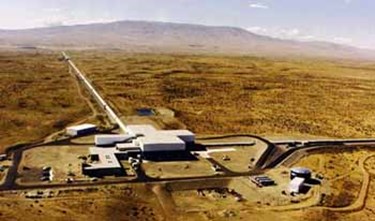Upgraded LIGO Resumes Hunt For Colliding Black Holes And Gravitational Waves
By Jof Enriquez,
Follow me on Twitter @jofenriq

The Laser Interferometer Gravitational-Wave Observatory (LIGO) is ready to resume tracking colliding black holes and the elusive gravitational waves these cataclysmic events generate through space-time. LIGO had been temporarily offline since January 2016 for scheduled upgrades and maintenance, with scientists adding components to extend its range and sensitivity.
Both LIGO detectors – located in Livingston, La., and Hanford, Wash., respectively – detected for the first time on Sept. 14, 2015 (confirmed Feb. 11, 2016) gravitational waves produced by a merger of two black holes that took place 1.3 billion years ago. It's a landmark event in modern physics that came a century after Albert Einstein theorized about the existence of gravitational waves in his general theory of relativity, and one that opens windows into a new era of astronomy. A second detection on Dec. 26, 2015 was announced by LIGO on June 15, 2016.
The detections during this run were credited by scientists to upgrades made in the Advanced LIGO program. Since the run ended in January 2016, LIGO scientists have upgraded lasers, electronics, and optics to increase the detectors' sensitivity and range for detecting gravitational waves from binary black holes.
"With our improved sensitivity, and a longer observing period, we will likely observe even more black-hole mergers in the coming run and further enhance our knowledge of black-hole dynamics. We are only just now, thanks to LIGO, learning about how often events like these occur," says Caltech's Dave Reitze, executive director of the LIGO Laboratory, in a news release.
The Livingston detector is now 25 percent more sensitive "for lower gravitational-wave frequencies, below about 100 hertz, primarily as the result of reducing the level of scattered light, which can be a pernicious source of noise in the interferometers," says Peter Fritschel, LIGO's chief detector scientist and the associate director for LIGO at MIT, which jointly built and operates LIGO with Caltech.
"We did a lot of work inside the vacuum system, replacing or adding new components," Fritschel told MIT News. He said the researchers designed and installed some tuned, passive dampers to reduce the oscillation amplitude of vibrational modes of the suspension systems on which test masses are mounted, to "help the Livingston detector operate at its peak sensitivity for a greater fraction of the data run duration."
MIT researchers are trying to make LIGO doubly sensitive by adding a new squeezed vacuum source in the next year or so. These would make LIGO particularly sensitive at the higher frequencies important for understanding the composition of neutron stars and their collisions, thought to be the source for most heavy elements, such as precious metals.
The Hanford detector will have about the same sensitivity as it did during the initial run, but it underwent upgrades to improve overall stability and increase the power into the interferometer.
"We are now operating with 20 to 30 percent higher power than we had in the first observing run. This modest power increase gives a small but noticeable increase in sensitivity to gravitational wave frequencies higher than about 100 hertz," Fritschel told MIT News.
"Furthermore, with the addition of specialized sensors called balance-beam tilt meters in the corner and end stations, the detector is now more stable against wind and low-frequency seismic motion, thereby increasing the amount of time the detector can be in observing mode," added Caltech's Mike Landry, the head of LIGO Hanford Observatory, in the news release.
The latest round of upgrades and repairs will be tested as the machines collect data for a six-month period, according to Wired.
"LIGO's scientific and operational staff have been working hard for the past year and are enthusiastic to restart round-the-clock observations. We are as curious as the rest of the world about what nature will send our way this year," says LIGO Livingston Observatory head Joe Giaime, of Caltech and Louisiana State University.
Scientists wrote in the journal Nature that LIGO could potentially detect about 1,000 black hole mergers per year, with total masses of 20–80 solar masses, once the second-generation ground-based gravitational-wave observatories reach full sensitivity.
